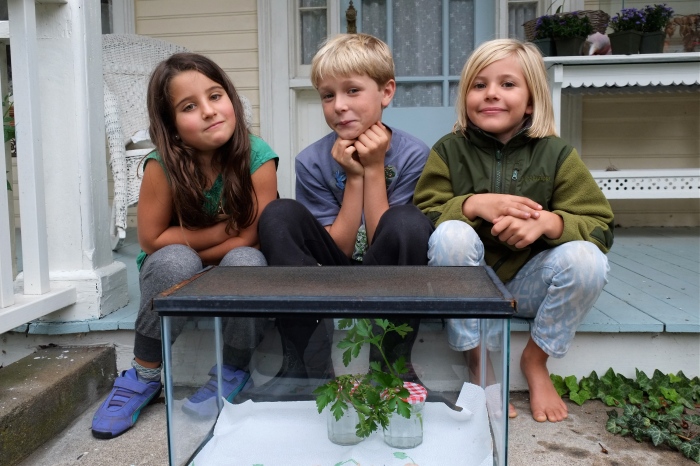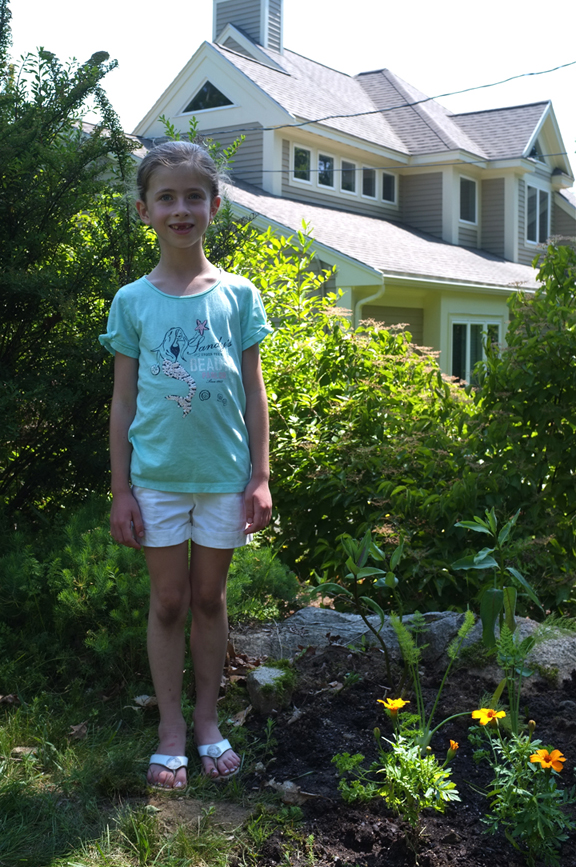On Tuesday morning, October 4th, I’ll be at the Corinthian Yacht Club in Marblehead to give my lecture on “The Pollinator Garden,” at 9:30am. I hope to see you there!
No, That is Not a Monarch Caterpillar on Your Carrot Plant
By far the most popular post on my Kim Smith Designs website is titled “No, That is Not a Monarch Caterpillar on Your Parsley Plant.” It has been the most trafficked post for several years, if you can believe it, and here is why.
Last fall, almost exactly to the day, through my office window I heard the sound of sweet voices on our front porch, well after dark, and wondered what our neighborhood dog walkers were doing out so late. It wasn’t dog walkers, but our neighbor Sharon and her son Treely, wondering what to do with what they thought was a Monarch caterpillar they had found in their garden. I sent them on their way with one of our terrariums and instructions on how to care for their little Black Swallowtail caterpillar.
Treely’s Black Swallowtail caterpillar turned into a chrysalis (in other words, pupated), spent the winter in the terrarium in a sheltered spot outdoors, and then emerged right on schedule this past spring. The Dowds returned the terrarium as it was needed later in the summer for our Cecropia Moth caterpillars.
Imagine how sweetly funny to get a call from my friend Michelle, wondering what to do with their newly discovered Monarch caterpillar. My first question to Michelle was did she find the caterpillar on her milkweed. No, she reported, it was found on carrot foliage. Michelle and her children, Meadow and Atticus, along with friend Sabine, stopped by this afternoon to learn about how to take care of their tiny little Black Swallowtail caterpillar and I sent them on their way with the ‘traveling terrarium.’
If you find a caterpillar in your garden, the first clue to identifying is to see on what food plant they are munching. Caterpillars that are actively feeding are usually only found on their larval host plant(s), the plant they have developed a distinctive coevolutionary relationship with over millennia. For example, female Monarch butterfly caterpillars deposit their eggs only on members of the milkweed family. Black Swallowtail caterpillars eat the foliage only from plants in the carrot family, which includes carrots, parsley, dill, fennel, parsnips, and Queen Anne’s lace. You may have noticed if ever weeding Queen Anne’s lace that the root looks identical in shape to a carrot, only it is white.
Chances are, you will never find a Black Swallowtail caterpillar on you milkweed plants and conversely, you will never find a Monarch caterpillar on your carrot plant (or parsley, dill, or fennel).
I am excited to hear from Michelle and the kids how their little caterpillar is developing over the next few weeks!






